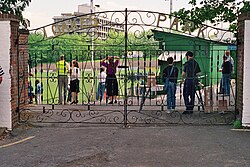
Hillsborough Stadium is a 39,732-capacity association football stadium located in Owlerton, a north-western suburb of Sheffield, Yorkshire, England. It has been the home of Sheffield Wednesday since its opening in 1899.

Molineux Stadium in Wolverhampton, West Midlands, England, has been the home ground of Premier League club Wolverhampton Wanderers since 1889. The first stadium built for use by a Football League club, it was one of the first British grounds to have floodlights installed and hosted some of the earliest European club games in the 1950s.
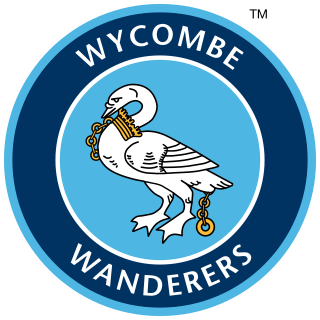
Wycombe Wanderers Football Club is an English professional association football club based in the town of High Wycombe, Buckinghamshire. The team compete in League One, the third tier of the English football league system. They play their home matches at Adams Park, located on the western outskirts of High Wycombe.

Villa Park is a football stadium in Aston, Birmingham, England, with a seating capacity of 42,682. It has been the home of Premier League side Aston Villa since 1897. The ground is less than a mile from both Witton and Aston railway stations and has hosted sixteen England internationals at senior level, the first in 1899 and the most recent in 2005. Villa Park has hosted 55 FA Cup semi-finals, more than any other stadium.

Selhurst Park is a football stadium in Selhurst in the London Borough of Croydon which is the home ground of Premier League side Crystal Palace. The stadium was designed by Archibald Leitch and opened in 1924. It has hosted international football as well as games for the 1948 Summer Olympics, and was shared by Charlton Athletic from 1985 to 1991 and Wimbledon from 1991 to 2003.

Kenilworth Road is an association football stadium in Luton, Bedfordshire, England. It has been the home ground of Luton Town Football Club since 1905. The stadium has also hosted women's and youth international matches, including the second leg of the 1984 European Competition for Women's Football final.

Adams Park is an association football stadium in High Wycombe, Buckinghamshire, England. Built in 1990, it is the home ground of the local Wycombe Wanderers in League One. It was also leased from 2002 to 2014 to the rugby union club London Wasps from Aviva Premiership, and from 2016 to 2020 to the Reading F.C. Women football club. From the 2003/04 season to the 2005/06 season, the stadium was officially called Causeway Stadium, named after its sponsor Causeway Technologies.

Home Park is a football stadium in Plymouth, England. The ground has been the home of Football League One club Plymouth Argyle since 1901.

Ewood Park is a football stadium in Blackburn, Lancashire, England, and the home of Blackburn Rovers F.C., founding members of the Football League and Premier League, who have played there since 1890. It is an all seater multi-sports facility with a capacity of 31,367, and four sections: the Bryan Douglas Darwen End, Riverside Stand, Ronnie Clayton Blackburn End, and Jack Walker Stand, named after Blackburn industrialist and club supporter, Jack Walker. The football pitch within the stadium measures 115 by 76 yards

Basingstoke Town Football Club is a football club based in Basingstoke, Hampshire, England. The club are currently members of the Isthmian League South Central Division and play at the Winklebury Sports Complex. Their motto, 'Vestigia Nulla Retrorsum', means 'Never a step backward'.
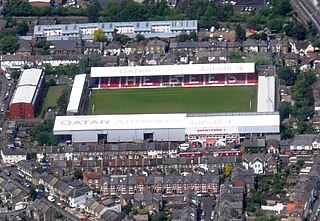
Griffin Park was a football ground in Brentford in the London Borough of Hounslow, England. It was the home ground of Brentford F.C. from its opening in September 1904 to August 2020. The ground is in a predominantly residential area and was known for being the only English league football ground to have a pub on each corner. The ground's name referred to the griffin featured in the logo of Fuller's Brewery, which at one point owned the orchard on which the stadium was built.
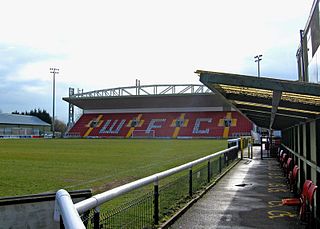
Kingfield Stadium, currently known as The Laithwaite Community Stadium for sponsorship reasons, is the home of Woking F.C. in the Kingfield area of Woking, Surrey which has a capacity of approximately 6,000, of which, 2,500 are seated on grandstands.

Bootham Crescent in York, England, was the home of York City football club and York City Knights rugby league club. With a capacity of 8,256, it is near the city centre, just over a mile from York railway station.

Underhill Stadium was a stadium in Chipping Barnet, London, that was the home of Barnet Football Club between 1907 and 2013. The club's under-19 team played fixtures there; it was also the training ground of the London Broncos rugby league club, and hosted Arsenal reserve games until 2012. Before closure the stadium was recorded as having a final capacity of 6,023; it was demolished in 2018, and is now the site of the Ark Pioneer Academy, which opened in 2019. The stadium was famous for its slope from the North to South end.
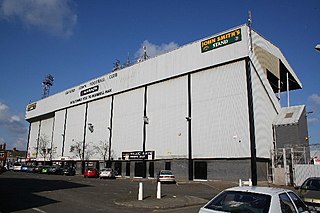
Blundell Park is a football ground in Cleethorpes, North East Lincolnshire, England and home to Grimsby Town Football Club. The stadium was built in 1899, but only one of the original stands remains. The current capacity of the ground is 9,052, after being made all-seater in summer 1995, reducing the number from around 27,000. Several relegations in previous years meant the expansion seating was also taken away; that reduced the capacity further from around 12,000 to what it is now.
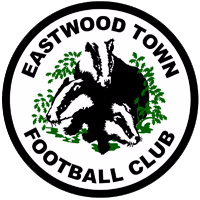
Eastwood Town Football Club was an English football club based in Eastwood, Nottinghamshire. The club last participated in the Northern Premier League Division One South, the eighth tier of English football.
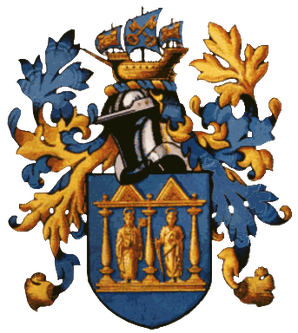
Wisbech Town Football Club is a football club based near Wisbech, Cambridgeshire, England. The club are currently members of the United Counties League Premier Division North and play at the Fenland Stadium.

York Road is a football stadium in Maidenhead, Berkshire, England. The home ground of Maidenhead United, it is acknowledged by The Football Association and FIFA to be the oldest continuously-used senior association football ground in the world by the same club, having been home to the club since 1871. A blue plaque commemorating this is placed just inside the home turnstiles on the York Road side of the ground.

Huish Athletic Ground, more commonly referred to as Huish, was a football stadium located in Yeovil, Somerset, England. It was the second home ground of Yeovil Town Football Club, after the Pen Mill Athletic Ground which they left in 1920, until the club's departure for Huish Park in 1990.
The history of Wycombe Wanderers F.C. covers the full history of the club from its formation to the last completed season.
